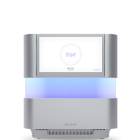Benchtop sequencers give users the power of next-generation sequencing (NGS) in a flexible and accessible design. Built with operational simplicity including preconfigured analysis workflows, these systems enable novice and experienced NGS users to bring NGS in-house and perform targeted sequencing across a range of applications.
A benchtop sequencer can provide a cost-efficient solution for low and mid-throughput applications and for library quality control (QC) prior to large-scale studies.




